
Charlie Brooks
Nov 28, 2022 16:18

On Monday, oil prices fell more than $2 per barrel, with WTI reaching a low not seen in eleven months, as demonstrations in China over stringent COVID-19 restrictions exacerbated demand concerns.
Brent oil slid $2.16, or 2.6%, to $81.47 per barrel at 02:30 GMT, after hitting its lowest level since January 11 at $81.16 per barrel earlier in the day.
The price of a barrel of West Texas Intermediate (WTI) oil in the United States decreased by $2.08, or 2.7%, to $74.20. Earlier, it hit a low of $73.82, its lowest level since December 27, 2021.
Both indexes have dropped for three consecutive weeks after reaching 10-month lows last week. Brent fell 4.6% during the past week, while WTI fell 4.6%.
"Unusual demonstrations against the government's severe COVID laws in Shanghai fueled sales," stated Hiroyuki Kikukawa, general manager of research at Nissan Securities (OTC: NSANY).
Depending on the conclusion of the OPEC+ meeting and the price cap for Russian crude oil, he stated that the market might stay turbulent.
China, the largest oil importer in the world, has committed to President Xi Jinping's zero-COVID policy despite the fact that much of the rest of the world has loosened restrictions.
Hundreds of protesters and police clashed in Shanghai on Sunday night, as demonstrations over China's draconian COVID laws flared for a third day and spread to numerous cities after a devastating fire in the country's far west.
The growth of civil disobedience in mainland China is unparalleled since Xi's ascent to power a decade ago, as unhappiness with his zero-COVID policy increases nearly three years into the pandemic.
Tetsu Emori, chief executive officer of Emori Fund Management Inc., observed, "On the oil market, pessimism is increasing due to rising concerns over China's demand and the absence of tangible signs from oil producers to further reduce output."
Unless OPEC+ agrees to a further reduction in production limits or the United States replenishes its strategic petroleum stockpiles, he cautioned that oil prices may continue to fall.
On December 4, OPEC+, often known as the Organization of Petroleum Exporting Countries and its supporters, will convene.
In October, OPEC+ agreed to reduce its production target by 2 million barrels per day through 2023.
Saadoun Mohsen, a senior official at Iraq's national oil marketer SOMO, was reported by the country's state news agency on Saturday as saying that the upcoming OPEC+ meeting will review the market's situation and equilibrium.
In addition, investors focused on measures by the West to limit the price of Russian oil.
Diplomats from the Group of Seven (G7) and the European Union have been discussing a ceiling price of between $65 and $70 per barrel for Russian oil, with the aim of limiting Moscow's ability to fund its military campaign in Ukraine without disrupting global oil markets.
EU ambassadors reported that a November 25 evening meeting of European Union government leaders to discuss the issue had been canceled. On Thursday, EU members were divided about the right oil price cap for Russia.
The price cap is expected to take effect on December 5, when the EU ban on Russian crude oil goes into effect.

Nov 28, 2022 16:15

Nov 29, 2022 11:53